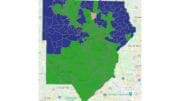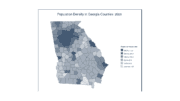by Larry Felton Johnson
Redistricting will be seriously underway soon, and Cobb County will almost certainly see changes in its legislative districts.
By August 16, the U.S. Census Bureau will release detailed demographic data gathered in the 2020 Census, and when that data becomes available, the fight over the shape of districts that takes place every ten years will begin.
Earlier in year the Census Bureau released the first results of the 2020 census, showing the overall U.S. population (now standing at 331.4 million) and the populations within each state. Those figures determined the number of members of the House of Representatives apportioned to each state.
With a population of 10,725,274, Georgia’s number of representatives remains unchanged at 14.
The August data release will set the stage for the periodic fight over redistricting.
Cobb County now has portions of three seats in the U.S. House of Representatives (the 6th, the 11th, and the 13th).
Like in every redistricting, the Cobb legislative delegation is likely to change.
That is what makes the August figures so important to residents of Cobb County.
According to the Census Bureau’s announcement:
Aside from showing how the ethnic, racial, and voting age makeup of neighborhoods has changed since the 2010 Census, these detailed data will be used by most state legislatures to redistrict or redraw their political districts for elections.
The announcement states, “The August data release will provide the first look at the demographic characteristics of the nation by state, county and city (down to the census block level), including:
- Race and ethnicity.
- Voting-age population.
- Occupied and vacant housing units.
- People living in group quarters like nursing homes, prisons, military barracks and college dorms.”
“While the primary purpose of these data is for states to redraw their districts, these statistics will also tell us how many people live in each county, in each city and in each block,” James Whitehorne, chief of the Census Bureau’s Redistricting and Voting Rights Data Office stated for the Census Bureau’s press release. “This information will provide a detailed demographic portrait of our nation’s population for communities all across the United States.”
To keep up with the Georgia legislature’s House and Senate reapportionment and redistricting committees, follow this link to the schedule.





